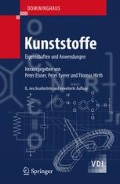Zusammenfassung
In den letzten Jahren gewannen Polymere mit besonderen Eigenschaften zunehmend an Bedeutung. In diesem Kapitel werden unter dem Überbegriff Spezialkunststoffe die zwei Gebiete „Biopolymere“ und „Elektrisch leitfähige Polymere“ behandelt.
Access this chapter
Tax calculation will be finalised at checkout
Purchases are for personal use only
Preview
Unable to display preview. Download preview PDF.
Literatur — Kapitel 4.1.2
Schröter E (1998) Von Anfang bis Ende Natur. Kunststoffe 88: 892–893
Hofmann T, Linke L, Tsiapouris A, Ziems A (1998) Poröse Werkstoffe auf Stärkebasis; Chemie Ingenieur Technik (70): 722–726
Römpp-Chemielexikon Bd 5, 10. Auflage. Falbe J, Regitz M. (Hrsg) Georg Thieme Verlag, Stuttgart, S 3369–43635
Bichler C, Bischoff M, Langowski HC, Moosheimer U, Utz UH (1995) Vakuumbedampfung biologisch-abbaubarer Folien. Spektrum d. Wissenschaft S 84–87
Vorwerg W, Loth F (1994) Stärke und Cellulose für neue Anwendungen. Spektrum d. Wissenschaft S 107–113
Literatur — Kapitel 4.1.3
Hartmann MH (1998) High Molecular Weight Polylactic Acid Polymers. In: Kaplan DL (Hrsg) Biopolymers from Renewable Resources. Springer-Verlag, Berlin, Heidelberg, S 367–405
Drumright RE, Gruber PR, Henton DE (2000) Polylactic Acid Technology. Advanced Materials 12 Nr. 23, 1841–1846
Witzke DR (1996) Properties and Engineering of Polylactide Polymers. Thesis, Michigan State Univ
Chiellini E, Solaro R (1996) Biodegradable Polymeric Materials. Advanced Materials 8. Nr. 4, 305–313
Conn RE, Kolstad JJ, Borzelleca JF, Dixler DS, Filer LJ, LaDu BN, Pariza MW (1995) Food and Chem Toxic 33 (4): 273–283
Sinclair RG (1996) J Mat Sci; Pure Appl Chem A33(5): 585–597
Gilding DK, Reed AM (1979) Polymer 20: 1459–1464
Raschke M, Marek A, Otten A, Widdecke H (2000) Technische Kennwerte und Verarbeitungsparameter von bioabbaubaren Kunststoffen, Wolfsburg: Institut für Recycling, 138 S.
Perrin DE, English JP (1997) Polyglycolide and Polylactide. In: Domb AJ, Kost J, Wiseman DM (Hrsg) Handbook of Biodegradable Polymers. Hardwood Academic Publishers, Amsterdam, S 3–26
Lunt J (2000) Polylactic Acid Polymers for Fibres and Nonwovens. International Fibres Journal, S. 48–52
Farrington DW, Lunt J, Davies S, Blackburn RS (2005) Poly(lactic acid) fibres, Biodegradable and Sustainable Fibres, Woodhead Publishing Limited, S. 191–220
Literatur — Kapitel 4.1.4
Kaplan DL (Hrsg) (1998) Biopolymers from Renewable Resources, Springer-Verlag, Berlin Heidelberg, S 220–244
Lemoigne M (1925) Ann Inst Pasteur 41:148–165
Lemoigner M (1925) Bull Soc Chim Biol 8:770–782
Domb AJ; Kost J; Wiseman DM (1997) Handbook of Biodegradable Polymers, Hardwood Academic Publishers, S 79–97.
Gross RA; DeMello C; Lenz RW; Brandl H; Fuller RC (1989) Macromolecules 22:1106
Chiellini E; Solaro R (1996) Adu Mater 8, Nr. 4, 305
Holmes PA (1988) Developments in Crystalline Polymers. Applied Science, S 1
Literatur — Kapitel 4.1.5
Leuschke CH u M Wandel (1982) Neue weichmacherfreie Werkstoffe auf Celluloseesterbasis, Plastverarbeiter 33, S 1095–1198
Gilbert AD (1994) Cellulosis Polymers, C. Hanser Verlag, München
Wandel M u. Ch Leuschke (1984) Celluloseester, Kunststoffe 74, S 589–592
Literatur — Kapitel 4.1.6
Bahadir M, Parlar H, Spiteller M (Hrsg) (2000): Springer Umweltlexikon, 2. Aufl., Springer Verlag, Berlin Heidelberg
Literatur — Kapitel 4.1.7
Adolph G, Roloff T Oleochemical building blocks and additives for two component polyurethane systems for civil engineering application
Riedel U Naturfaserverstärkte Polymere: Stand der Technik und Perspektiven. 4. Internationale AVK-TV Tagung 11.-12.10.2001, Baden-Baden
Skwiercz M Duroplaste aus nachwachsenden Rohstoffen 7. Symposium Nachwachsende Rohstoffe für die Chemie 20.-22.03.2001, Dresden
Literatur — Kapitel 4.1.8
Studie Wood Plastic Compounds. nova-Institut GmbH, Hürth, 2006
Endres HJ (2009) Technische Biopolymere. Hanser-Verlag
Stassen P (2007) New Ultrapure Coupling Agents for Enhancing the Performance of Olefinic LFT&DLFT Composites. AddComp, ACCE
Hauk J (2010) Technische Mitteilung Baerlocher GmbH, Unterschleissheim
Dominik M (2006) Viel Potential für Verbesserungen. Kunststoffe 9(2006), S. 187–191
Campos AR (2008) NATURPLAS — New materials based on natural resources from the euroregion — industry applications. 1st PLA World Congress Munich, 9–10 September 2008
Rudloff J (2008) Von der Rezeptur bis zum Bauteil. Kunststoffe 2(2008), S. 64–67
Interner Bericht (2006) Fraunhofer-Institut für Chemische Technologie ICT, Pfinztal
Kampf A (2008) Fasern aus der Natur. J. Rettenmaier & Söhne, 11(2008)
Hiendl H (2009) NFC Profil ermöglicht störungsfreie EMV Messungen. H. Hiendl GmbH & Co. KG, Biowerkstoff-Kongress 2009, Stuttgart
P. Mosshammer (2000) Untersuchung der Einflüsse des Messzubehörs und der Umgebung auf die Messunsicherheit, Diplomarbeit an der FHTW Berlin
Schulz W (1970) Dielektrische und magnetische Eigenschaften der Werkstoffe, Vieweg Verlag, Braunschweig
Huber T (2008) Verstärkung aus der Natur. Kunststoffe 7 (2008), S. 97–101
Literatur — Kapitel 4.2
Roth S (1989) Selbstleitende Kunststoffe. In: Mair HJ (Hrsg) Elektrisch leitende Kunststoffe 2. Auflage, Hanser Verlag, München, 569 S
Kauffmann A (2003) Hochgefüllte elektrisch leitfähige Thermoplaste für Bipolarplatten in Brennstoffzellen. 7. VDI-Kunststoff-Forum Münster. Spezial-und Hochleistungskunststoffe — Perspektiven und Potentiale, Münster.
Brendel U, Münstedt H (1996) Permanent antielektrostatische Kunststoffe, Kunststoffe 86, Hanser Verlag, München
Münstedt H (1989) Elektrisch leitfähige Polymere, Kunststoffe 79, Hanser Verlag, München
Ivers-Tiffée E (1997) Institut für Werkstoffe der Elektrotechnik IWE: Werkstoffe für die Energie-und Umwelttechnik
Möbius KH (1989) Füllstoffhaltige elektrisch leitfähige Kunststoffe, Kunststoffe 79, Hanser Verlag, München
Münstedt H (1989) Vergleich von gefüllten und intrinsisch leitfähigen Kunststoffen. In: Mair HJ (Hrsg) Elektrisch leitende Kunststoffe 2. Auflage, Hanser Verlag, München, 569 S
Wenderoth KL (1988) Leitfähige Polymermischungen zur Abschirmung elektromagnetischer Wellen, Reihe 5: Grund-und Werkstoffe, VDI-Verlag, Düsseldorf
Gilg RG (1995) Ruß und andere Pigmente, 6. Technische Akademie Esslingen, Esslingen
Pfeiffer B, Celstran S (1996) Konstruktionswerkstoffe mit Edelstahlfasern gefüllt für ESDund EMV-Anwendungen; Lehrgang Technische Akademie Esslingen ‚Elektrisch leitende Kunststoffe‘
Leute U (1997) Kunststoffe und EMV, Elektromagnetische Verträglichkeit mit leitfähigen Kunststoffen, Hanser Verlag, München Wien
Hempelmann S (1996) Oberflächentechnik und EMV, mo metalloberfläche, Hanser Verlag
Eyerer P, Hirth Th, Elsner P (Hrsg) (2007) Polymer Engineering, Springer Verlag, Berlin
Editor information
Editors and Affiliations
Rights and permissions
Copyright information
© 2012 Springer-Verlag Heidelberg
About this chapter
Cite this chapter
Hirth, T. et al. (2012). Spezialkunststoffe. In: Elsner, P., Eyerer, P., Hirth, T. (eds) Kunststoffe. VDI-Buch. Springer, Berlin, Heidelberg. https://doi.org/10.1007/978-3-642-16173-5_4
Download citation
DOI: https://doi.org/10.1007/978-3-642-16173-5_4
Publisher Name: Springer, Berlin, Heidelberg
Print ISBN: 978-3-642-16172-8
Online ISBN: 978-3-642-16173-5
eBook Packages: Life Science and Basic Disciplines (German Language)

